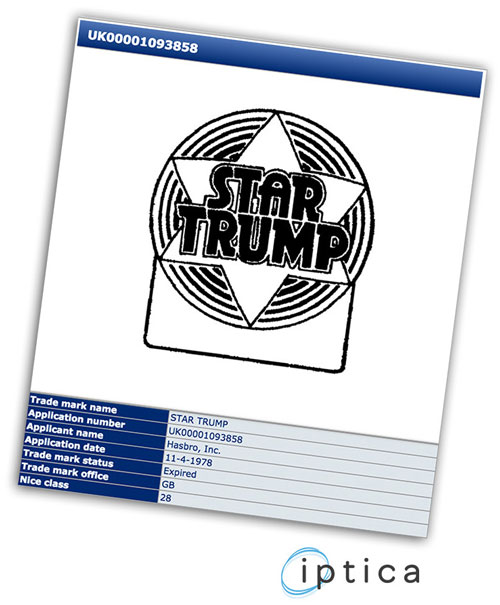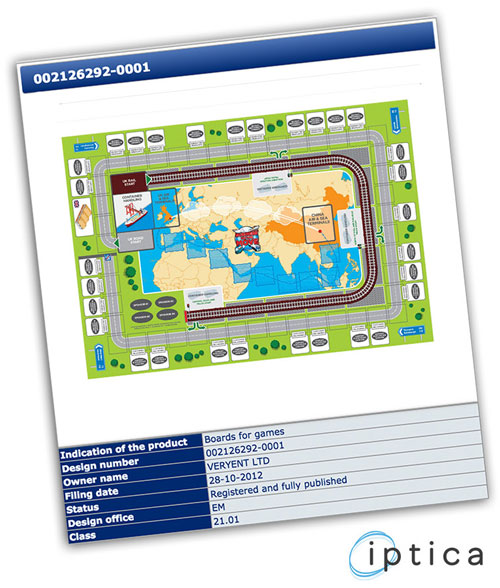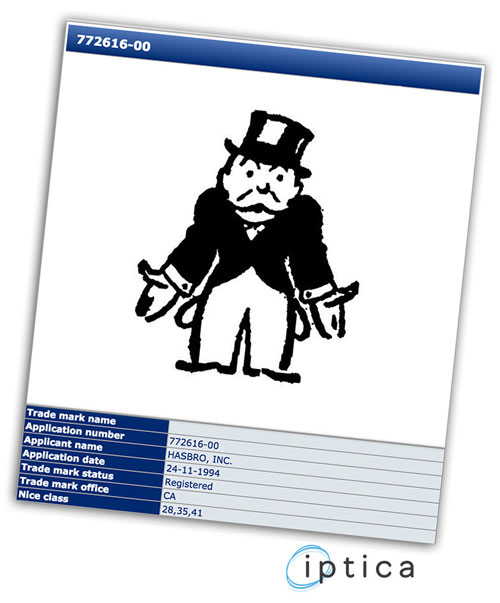


Monopoly
The board game MONOPOLY was invented in 1903 by Lizzie Magie, who continued to develop it for another 20 years. She tried hard to protect and commercialise the game. But, her patents, trademarks and designs were ultimately "stolen" by three different people … lawfully, and with the approval of the US Patent and Trademark Office!
How was Monopoly protected? And, how did Lizzie end up empty‐handed?
Monopoly Trademark:
In 1906, the Monopoly board game was launched under the name "THE LANDLORD'S GAME".
In 1935, Parker Brothers Inc. printed its own version of the game under the name MONOPOLY ‐ a brand, which the company registered as US trademark no. 326723 (current status: "in force"):

Today, more than 90% of the Monopoly board game value can be attributed to the trademark registrations.
Since Parker Brothers was first to file a trademark application for this new brand, Parker Brothers is recognised as the 100% owner of the name MONOPOLY.
But, what happened to the original brand "THE LANDLORD'S GAME"?
Well, on 13 August 2013, since:
- there was no conflicting marks on the US trademark register at that time; and
- this brand had not been used on board games for a while,
the US Trademark Office registered US trademark no. 4384181 for "THE LANDLOR'S GAME" in the name of Thomas Forsyth:

Today, Thomas Forsyth claims to be the only person permitted to sell exact replicas of the original LANDLORD'S GAME, as per the original designs, rules and branding by Lizzie! Seriously? $10 to anyone who on‐steals this from him.
Trademark filing tip: file board game trademarks in class 28, and use the ™ symbol before grant. Only add the ® symbol in countries where you have a registered trademark.
Monopoly Patents:
To be valid, a patent claim must be "new" and "inventive". When writing a patent claim, the first goal is to list a "combination" of features that is unique when compared to existing games. Since board games often have many features, select features (introduced by Roman numerals in the claims below) may be grouped together in various novel "combinations" / claims.
The inventor of Monopoly Lizzie Magie filed her first patent US748626 "Board game" on 23 March 1903:

Claim 1: A game‐board, having: (i) corner‐spaces, one constituting the starting‐point; and (ii) a series of intervening spaces indicating different denominations, some of the spaces of the different series corresponding, and distinguished by coloring or other marking, so that the corresponding divisions on the four spaces may be readily recognised. [Note: "the four spaces" appears to be a reference to four spaces in the center of the board indicating "Bank", "Wages", "Public Treasury" and "Railroad". A card box was to be places on each of these spaces.]
Claim 2: A game‐board, provided with: (i) corner‐spaces; (ii) intervening spaces of different denominations, some of the spaces of the different series corresponding, and distinguished by coloring or other marking, so that the corresponding spaces in the different divisions may be recognised; and (iii) a series of movable pieces having reference to the different divisions upon the board.
Claim 3: A game‐board, having: (i) a series of divisions of different denominations upon its outer border, one constituting the starting‐point; (ii) four divisions within said series for the reception of boxes; (iii) a series of movable pieces having reference to the spaces upon the board; and (iv) a chance device to control the movement of the pieces.
Claim 4: A game‐board, provided with: (i) corner‐spaces; (ii) intervening spaces of different denominations, and distinguished by distinctive markings, so that the corresponding divisions on the different spaces may be recognized; (iii) movable pieces having reference to the spaces; (iv) a chance device to control the movement of the pieces; (v) checkers; and (vi) and tickets representing money, deeds, notes, mortgates, bank mortgages, charters, legacies, and luxuries, adapted to be used in connection with the same.
20 years later, Lizzie improved the game and filed her second patent US1509312 "Game board":

Claim 1: A game‐board, provided with: (i) corner spaces; (ii) intervening spaces of different denominations and values, some of the spaces of the different series corresponding and distinguished by coloring or other marking, so that the corresponding divisions may be recognised; (iii) a series of cards of changeable value, two or more of which are alike and which relate to two or more certain spaces on the board; and (iv) a series of movable pieces to be used in conjunction with the spaces of the board and controlled by dice, so as to determine the play.
Claim 2: A game‐board, provided with: (i) corner spaces; (ii) intervening spaces having distinctive markings, some of the intervening spaces corresponding with each other, movable and interchangeable pieces which may be used in combination with the board and with each other; (iii) dice; and (iv) a cube to be used in combination with the dice and with the board, said cube having upon its faces symbols to indicate a condition or a move.
Claim 3: A game‐board, provided with: (i) intervening spaces of different denominations and values and distinguished by suitable marking; (ii) dice; (iii) cards representing franchises, title to land in use and to land held out of use, improvement tags; (iv) checkers; and (v) a chance cube to be used with the dice and with the board.
Claim 4: A game‐board, provided with: (i) corner spaces; (ii) intervening spaces having distinctive markings, some of them representing offices and buildings, railroad transportation, foreign ownership of American soil, wages, land in use and land held out of use; (iii) a series of cards of changeable value; (iv) tags representing improvements on the land; (v) money pieces; (vi) no trespassing signs; (vii) for sale signs; and (viii) a cube to be used in combination with the board, said cube having upon its faces symbols to indicate a condition or a move.
Claim 5: A game‐board, provided with: (i) corner spaces; (ii) intervening spaces, some of the intervening spaces being identical, in combination with a pack of cards some having changeable value and having relation to more than one board space, tags representing improvements; (iii) money pieces; (iv) no trespassing signs (v) for sale signs; (vi) checkers to indicate the action of the different players; (vii) a pair of dice; and (viii) a chance cube to be used with the dice and board, said cube having symbols to indicate a condition or a move.
However, on 31 August 1935, the US Patent Office registered US2026082 "Board game apparatus" in the name of Charles Darrow (who claimed to be the only inventor of the game):

Claim 1: In a board game apparatus a board acting as a playing‐field having marked spaces constituting a path or course extending about the board, said path affording a continuous track for the purpose of continuity of play, certain of said spaces being designated as by position or colour so as to constitute a distinguishable group, there being a plurality of such groups each differing from the others and each having its spaces adjacent on the same side of the board, the apparatus having indications of the rentals required for the use and occupancy, by opponent players, of spaces of one or more such groups, which rentals are subject to increase by the acquisition of an additional space or spaces of the same group by the same individual player, thereby making it possible for the possessor to exact greater payments or penalties from any opponent resting or trespassing thereon.
Claim 2: … also including a first set of cards containing advantages or disadvantages for the player receiving one of more of such cards, the cards to be drawn by players as determined by chance.
Claim 3: … also including: (i) a second set of cards bearing indications as by color or title showing that these cards respectively relate in the play of the game solely to definite, similar indicated spaces upon the board; (ii) a set of pieces to represent buildings for the purpose of purchase and placement on spaces on the board owned by the purchasing player; (iii) a set of playing pieces for the purpose of registering movement, each differentiated from the other; and (iv) dice or the like to control certain movements in the game.
Charles ended up selling "his" game to Parker Brothers, and the rest is history.
Provisional patent filing tips: The provisional patent document should:
- describe the board, each card and the "pieces" (e.g. tokens, checkers and dice);
- describe the rules of the game; and
- include drawings of the board, cards and "pieces".
Unlike complete patents, a provisional patent does not require a set of claims.
Monopoly Designs:
Monopoly did not file a design registration for its board or for its game pieces. However, if Lizzie Maggie were to re‐file her board game today, she would likely file a design similar to this one:

No, we've not kicked‐off a round of "spot the difference". Christopher Hunt really did apply for, and was granted this design registration by the US Designs Office in August 2016.
Design filing tips: name the article a "Game board", and file the design application in Class 21.
Copyright:
Copyright automatically protects the artwork in the game board and cards. However, rights in copyright typically expire 95 years from first publication, i.e. 2001. Now that Thomas Forsyth has taken images of the original boards, he claims rights in those images (copyright expiry date: 2108). We would love to show you an image of the original board, but we are at least 10% wimp, and require Thomas' consent to do so.
Copyright tip: Add the following to the game board and cards:
© [owner's name], [year created]
This is purely to notify others who the owner is and that copyright subsists in the works. No further registration is required.
Conclusion:
If you do not register:
- a patent for your game board, a Charles Darrow may end up stealing the invention from you;
- a trademark for your game board, a Thomas Forsyth may end up stealing the name from you; and
- a design for your game board, a Richard Hunt may end up stealing the layout from you.




Like our page on facebook:









